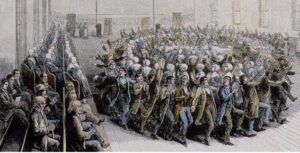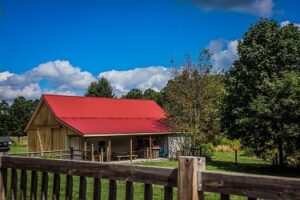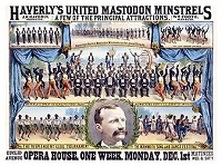
It seems a little unfair that the word “Shakers” nowadays calls up only a furniture style and, probably, the tune “Simple Gifts,” when this religious group had such a long and fascinating history. Honestly, the Wikipedia article about them is well worth a read if you’re at all interested in early American history and/or revivalist religious movements.
I’m going to get into Shaker music, but I do need to explain their beliefs and practices a bit in order to do so. This sect, which got its start in Britain around 1750, was a fascinating mixture of strict rules on the one hand and ecstatic outbursts on the other. Absolute celibacy was required for full membership; the sexes were housed separately and could not even shake hands or pass one another on the stairs. (I’m assuming the latter rule was in place because the staircases were so narrow.) They also lived communally and were strict pacifists. Yet their worship services were a mixture of music, dancing, and manifestations of spirituality that included twitching, jerking, and shouting, usually in some type of unknown language. (Those outward physical actions gave the group their name; originally they were called the “Shaking Quakers” and were an offshoot of the original Quakers.) They had to let off steam somehow, I guess. In spite of all the kerfuffle, though, the music itself was very plain, with no musical instruments used for accompaniment and no harmonies, just the melody. You can do a lot with a little; as our friend Wikipedia says:


 Sometimes I start researching these posts thinking that I know what’s what and I just need to fill in a few blanks, only find out that my ideas have been completely wrongheaded. Other times I think there’s not too much to say and end up with enough material for a doctoral dissertation. This post fulfills both conditions. Racism and the transformative power of art are all packed into this one short selection.
Sometimes I start researching these posts thinking that I know what’s what and I just need to fill in a few blanks, only find out that my ideas have been completely wrongheaded. Other times I think there’s not too much to say and end up with enough material for a doctoral dissertation. This post fulfills both conditions. Racism and the transformative power of art are all packed into this one short selection.